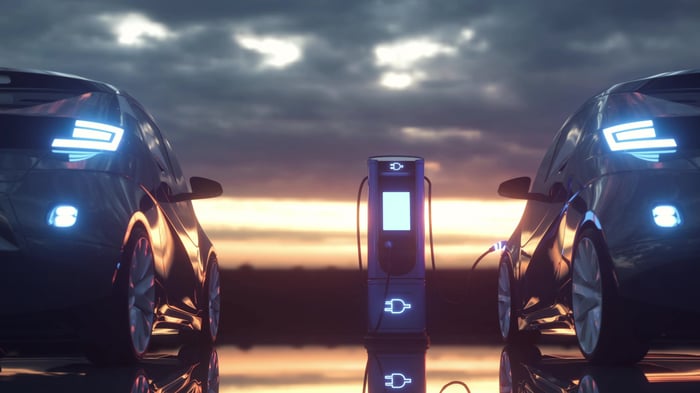All eyes are on Tesla’s production volume. But the company is making inroads in many AI-powered applications that appear overlooked right now.
Excitement surrounding breakthroughs in artificial intelligence (AI) have led to major gains in the stock market over the last year. The tech-heavy Nasdaq Composite surged 43% in 2023, and is up 8% already so far this year.
Much of these gains, however, can be attributed to a small cohort of stocks collectively known as the “Magnificent Seven” — a catchy moniker that includes Microsoft, Apple, Alphabet, Amazon, Nvidia, Meta Platforms, and Tesla (TSLA -2.90%).
Interestingly, Tesla is the only member of the Magnificent Seven that has had a negative return over the last year, down nearly 11% as of market close on April 5.
As its megacap peers continue to push the AI narrative forward, Tesla’s progress in artificial intelligence is going overlooked as demand for electric vehicles (EV) begins to cool. Let’s break down why now is a lucrative opportunity to consider scooping up shares of Tesla and preparing to hold long-term.
More than a car business
The main knock against Tesla is that the company is nothing more than a car business. While producing a battery-powered vehicle differentiates Tesla from many legacy automakers, bearish investors will also contend that it’s a costly endeavor.
Nevertheless, Tesla’s financial and operating results prove that there is a big market for EVs. In 2023, Tesla generated $96.8 billion in revenue, up 19% year over year. Roughly 85% of the company’s sales stemmed from the car business, with the remainder coming from Tesla’s energy storage and services operations.
Considering that unusually high inflation and rising interest rates weighed on the economy throughout 2023, I see these results as quite impressive. More importantly, Tesla managed to consistently operate at a profitable level last year, despite a tough macro environment.
Tesla increased its net income by 19% last year, reporting $15 billion on a generally accepted accounting principles (GAAP) basis. And even though the company’s $4.4 billion of free cash flow represented a 42% decline year over year, the more important point is that Tesla still remained in the green overall.
With more than $29 billion of cash on the balance sheet, let’s explore some ways Tesla is building outside of EVs.
Image Source: Getty Images
Rise of the robots
One of the more notable artificial intelligence (AI) projects Tesla is working on is in robotics. The company is developing a humanoid robot called Optimus, which it hopes to implement into factories in the long run.
The primary selling point is that factories operated by Optimus bots can achieve a new level of automation productivity. But a bigger goal concerns the labor industry. Should Tesla begin commercializing Optimus, humanoid robotics have an opportunity to upend manufacturing, logistics, retail, and more.
While a world integrated with humanoid robots may feel akin to science fiction, it’s worth noting that many other AI enterprises are also investing in the technology. For example, Nvidia joined Jeff Bezos and Intel earlier this year in a $675 million funding round for a start-up called Figure AI, which competes with Tesla’s Optimus. Moreover, ChatGPT developer OpenAI is invested in both Figure AI and an android start-up 1X.
Goldman Sachs forecasts a $38 billion addressable market for humanoid robotics by 2035. I wouldn’t sleep on this opportunity given Tesla’s early entrance in the space. Furthermore, with a $42 trillion labor market, Tesla has a greenfield opportunity to leverage robotics by augmenting its core car business and expanding outside of EV production.
A billion miles of data and counting
Another opportunity where AI can play a role for Tesla is autonomous driving. There are a lot of companies investing in self-driving capabilities, but not many have made measurable progress.
Over the last several months, a subsidiary of General Motors called Cruise faced significant hurdles in its autonomous driving roadmap. By contrast, Alphabet’s self-driving car business Waymo has attracted the likes of Uber for potential partnerships down the road.
But with more than 1 billion miles of data collected, Tesla has an edge over the competition. The company is the undisputed leader in self-driving data collection, which it uses to hone and train its autonomous driving software models.
Right now, Tesla stock trades at price-to-sales (P/S) ratio of just 5.9 — the second lowest among the Magnificent Seven. With shares down 34% so far in 2024, it’s hard to imagine things getting much worse.
Long-term investors should not discount the AI vision Tesla is creating beyond selling cars. The company is very much in the midst of the AI revolution — but with all eyes on car sales, investors are overlooking Tesla’s long-term opportunities. I think now is a terrific time to scoop up shares and buy the dip in Tesla stock.
